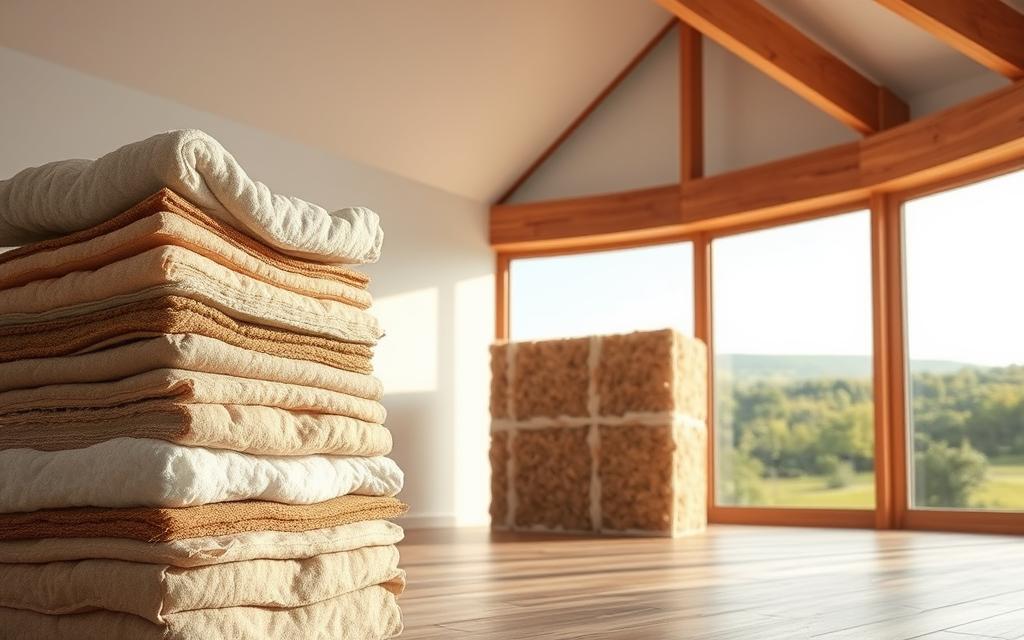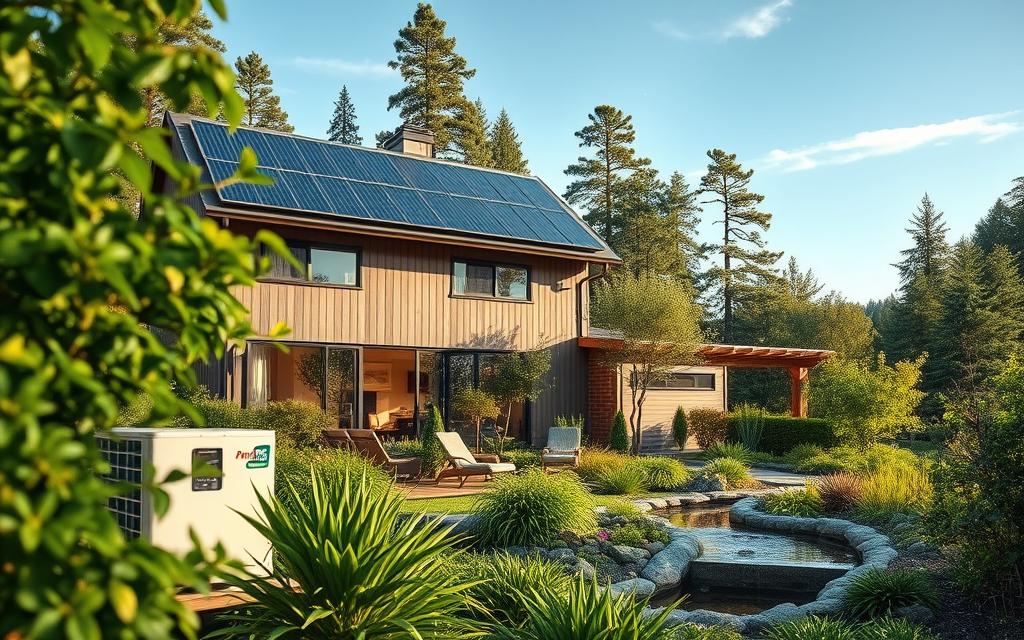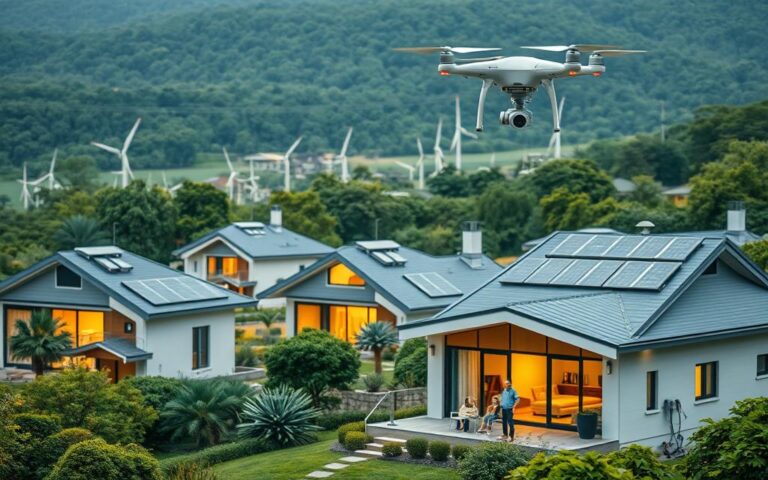Did you know that making your home energy-efficient can cut your bills by up to 30%? Lately, more people want green home tech that fits their values and wallets. Since the pandemic, many are choosing eco-friendly options for their homes.
There are many options today, like energy-saving appliances and solar power systems. We’ll look at affordable and effective ways to make your home greener and better for the planet.
Understanding Green Home Technology
Green home technology includes systems and appliances that help the environment. It makes homes more energy-efficient. Homeowners want to save money and help the planet.
They invest in sustainable living solutions. This reduces their carbon footprint and saves resources.
What is Green Home Technology?
Green home technology uses energy-efficient systems and materials. It aims to reduce waste and save energy. Homeowners use smart thermostats and eco-friendly products.
These tools help manage energy use. They lower utility costs and improve the environment.
Importance of Sustainability in Homes
Sustainable home practices offer many benefits. They are not just a trend but a necessity. Green technologies save money and improve health.
They make homes healthier by reducing pollutants. Homeowners help create a better planet and community.
| Benefits | Description |
|---|---|
| Cost Savings | Green technologies lower energy bills through enhanced efficiency. |
| Health Improvement | Reduced exposure to harmful substances promotes a healthier living environment. |
| Environmental Impact | Using sustainable materials and practices minimizes ecological harm. |
Benefits of Green Home Technology
Green home technology offers many benefits beyond looks. It saves money, improves health, and helps the environment. These advantages are significant and far-reaching.
Cost Savings on Energy Bills
One big plus of green home tech is saving on energy bills. Using energy-efficient appliances and better insulation cuts down on energy use. This means lower bills every month.
Over time, these savings add up. They make the cost of the technology worth it.
Healthier Living Environment
Green tech also makes homes healthier. It improves air quality and uses safe materials. This leads to fewer health problems like allergies.
Creating a healthy home is key for families. It’s about well-being and living sustainably.
Environmental Impact
Green home tech has a big positive effect on the environment. It uses renewable energy and sustainable materials. This reduces carbon emissions and helps fight climate change.
It also supports biodiversity and balances ecosystems. This is crucial for our planet’s health.
Energy-Efficient Appliances
Looking for a sustainable lifestyle? Energy-efficient appliances are key. They cut down energy use and make homes more comfortable. Options range from smart ovens to efficient HVAC systems, meeting various needs.
Using these appliances lowers bills and makes homes greener. They use the latest technology for a better environment.
Types of Energy-Efficient Appliances
Many appliances can make your home eco-friendly. Here are some:
- ENERGY STAR-rated appliances: These meet strict energy standards set by the U.S. Environmental Protection Agency.
- Smart ovens: They adjust cooking times and temperatures for better energy use.
- Efficient HVAC systems: They use less energy while keeping your home at the right temperature.
- Tankless water heaters: They provide hot water when you need it, saving energy.
- Dual-flush toilets: They use less water with two flushing options, saving resources.
How to Choose the Right Appliances
Choosing the right appliances is important. Consider these tips:
- Compare efficiency ratings: Look at ENERGY STAR ratings and other certifications for the best choices.
- Understand usage needs: Think about your household’s habits to pick the most used appliances.
- Consider long-term savings: Balance the initial cost with long-term energy savings for a smart buy.
Smart Home Integration
Smart home technology changes how we live, making our homes more comfortable and efficient. At the heart of this change are smart thermostats and lighting systems. They improve our comfort and help save energy. Let’s look at how these key parts make a modern, eco-friendly home.
Smart Thermostats
Smart thermostats give us full control over our home’s temperature. They learn our habits and adjust the temperature to fit our needs. This way, we stay comfortable while using less energy.
Devices like the Ecobee Smart Thermostat let us control our home’s temperature from our phones. They also give us energy reports. These reports help us make better choices about how we use energy.
Smart Lighting Systems
Smart lighting systems change how we use light in our homes. They turn lights on only when we need them, saving energy. Smart bulbs, like those from Philips Hue, work well with smart home tech.
With these bulbs, we can set schedules, create moods, and control lights with our voices or phones. This makes our homes more comfortable and helps the planet.
Solar Power Solutions
More and more homeowners are looking for green energy options. Solar power systems are at the forefront. They use the sun’s energy for sustainable living. Homeowners can choose from home solar panels and solar water heaters to cut down on traditional energy use.
Home Solar Panels
Home solar panels turn sunlight into electricity. This lets homeowners use clean energy. Installing these panels can greatly lower electricity bills.
They also boost your home’s value. With government programs like the Smart Export Guarantee (SEG), solar panels are easier to afford.
Solar Water Heaters
Solar water heaters heat water using the sun. They’re a great choice over traditional methods. They cut down on energy use.
Using solar water heaters saves money on utility bills. They help make our environment greener. These systems show how easy it is to live sustainably.
Eco-Friendly Insulation Options
Looking to upgrade your home’s energy efficiency? Eco-friendly insulation is key. The right insulation boosts comfort and energy savings. Today, many materials are available that are better for the planet and keep your home at the right temperature.
Types of Eco-Friendly Insulation
Homeowners are turning to sustainable insulation options. Here are a few:
- Cellulose: Made from recycled paper, it’s fire-resistant and keeps your home warm or cool.
- Rigid Foam: Thin and effective, it’s made from recycled materials.
- Spray Foam: It seals air well but needs careful use due to its chemicals. Choose eco-friendly types for best results.
Benefits of Insulation
Insulation brings many advantages:
- It keeps your home comfortable all year.
- It cuts down on heating and cooling costs, saving you money.
- It’s good for the planet, making your home more sustainable.
Choosing eco-friendly insulation improves your home’s energy use and helps the environment.

Water Conservation Technologies
Using water-saving technologies is key for our planet and saving money at home. Solutions like low-flow fixtures and rainwater harvesting systems cut down on water use. They keep things working well for us while helping the environment.
Low-Flow Fixtures
Low-flow fixtures are a smart choice for kitchens and bathrooms. They use less water but still work great. For example, a low-flow showerhead can save 2.5 gallons of water per minute.
They’re easy to install and come from brands like Moen and Delta. Making the switch is simple and beneficial for any home.
Rainwater Harvesting Systems
Rainwater harvesting systems are a green way to use rainwater. They collect and store rainwater for watering plants and other non-drinking uses. This can greatly reduce your water bill and use less from the city.
One system can save a family thousands of gallons of water each year. Using these systems helps our planet and ensures water for future generations.
Sustainable Materials for Home Renovation
Choosing the right materials for home renovation is key to a sustainable home. Using sustainable materials cuts down on environmental harm and boosts your home’s look. This part talks about the importance of recycled materials and green flooring options.
Recycled Building Materials
Recycled building materials are popular for their durability and eco-friendliness. Reclaimed wood adds a rustic touch and helps the planet. Recycled steel is strong and versatile, reducing landfill waste.
Eco-Friendly Flooring Options
There are many eco-friendly flooring choices that are stylish and sustainable. Bamboo flooring grows fast and is renewable. Cork, from cork oak bark, is warm underfoot and eco-friendly. Choosing these materials lowers your environmental impact and beautifies your home.
| Material | Benefits | Environmental Impact |
|---|---|---|
| Reclaimed Wood | Durable, unique aesthetics | Reduces deforestation and landfill waste |
| Recycled Steel | Strong, versatile construction | Significantly conserves natural resources |
| Bamboo Flooring | Fast-growing, stylish | Minimal environmental impact, renewable |
| Cork Flooring | Comfortable, good insulation | Sustainable harvesting practices |
Government Incentives for Green Technology
Homeowners looking to go green have many government incentives to help. These programs make it easier to afford upgrades. They encourage people to choose sustainable options, which are good for the planet and save money in the long run.
Federal Tax Credits
Federal tax credits are a big deal for green home upgrades. They help lower what you owe in taxes if you get solar panels or other green tech. For example, you can get big discounts on the cost of solar panels.
These credits make solar energy more affordable. They help the environment and save you money too.
State-Sponsored Rebates
States also offer rebates for green home upgrades. These rebates give you money back right away. They cover some of the cost for things like efficient water heaters and refrigerators.
By getting these rebates, you can save a lot of money upfront. This makes it easier to make your home more sustainable.
| Incentive Type | Description | Examples |
|---|---|---|
| Federal Tax Credit | Reduces taxable income for renewable energy investments. | Solar panels, wind turbines |
| State-Sponsored Rebate | Provides direct cash back for energy-efficient upgrades. | Energy-efficient appliances, insulation |
How to Plan Your Green Home Upgrade
Starting your green home upgrade journey needs careful planning. First, set a budget that fits your current finances and future energy-saving dreams. Knowing the costs of energy-efficient upgrades helps you make smart choices.
Set a Budget
When setting your budget, think about both the initial costs and the long-term savings. Look into low-interest loans to help with the upfront costs. This way, you can enjoy the benefits of energy efficiency without breaking the bank.
Prioritize Your Upgrades
After setting your budget, decide which upgrades are most important. Check your home for areas that need improvement, like old appliances or bad insulation. Focus on upgrades that save energy and help the environment. Also, use government programs that support green changes to make your upgrade easier.



